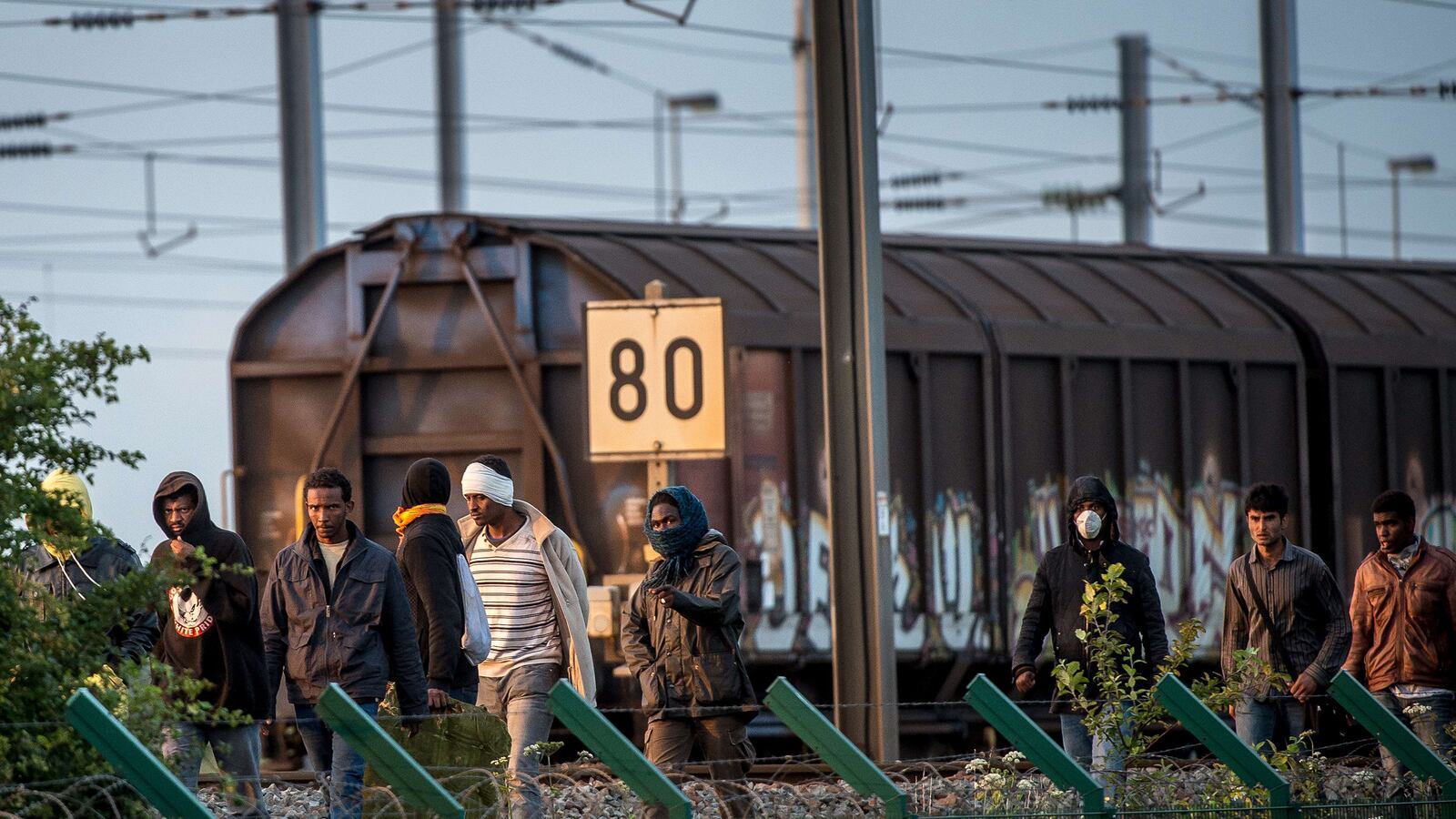Before they die, they have been funneled across oceans and continents into a 30-mile hole beneath the sea. There, they are crushed and suffocated and electrocuted.
Before they die, they often say their destination will be a paradise compared to where they’ve come from, but to get there they have to risk hell.
In the deepest Stygian dark, if they make it that far, trains full of tourists and students and business people pass by at high speed, and those aboard could not make out the blurred faces of the damned even if they cared to.
Indeed, few do until suddenly there is a riot, a suicide, or a machine-mutilated corpse that travelers will hear of only as a “technical incident” delaying their train.
Such is life and death in the Chunnel that links the Continent and Great Britain, the final frontier in the grim voyage of migrants and refugees making a bid to build new lives in Europe.
It has been like this for more than 15 years, but conditions are worse now than ever. Much worse.
This Wednesday afternoon, Le Parisien reported that a man, said to be of Egyptian nationality, was electrocuted around 2 p.m. when he tried to climb on to the Eurostar passenger train at the Gare du Nord station in the French capital.
He seems to have thought he could make the journey to and through the Chunnel like Tom Cruise in an old Mission Impossible movie, clinging to the roof of the train. Instead, he died.
On Tuesday, at least 1,500 migrants tried to rush the Eurotunnel terminal in the French city of Calais.
Much of the under-channel traffic is in trucks waiting at the terminal to be loaded on shuttle trains, and the illegal migrants try to stow away inside them, or even in their wheel wells.
One man, reportedly of Sudanese origin, was found dead after a truck hit him when it was coming off the nearby cross-Channel ferry.
The BBC reported that France is sending extra police officers to Calais.
Eurotunnel, which manages and operates the Channel Tunnel, said it had blocked 37,000 migrants trying to make their way to Britain since the beginning of 2015.
Thousands of people are living beneath cardboard and garbage bags in makeshift slums called “The Jungle” in and around Calais.
In years past, they were offered shelter by the Red Cross in an old hangar that had once housed the enormous machines drilling the tunnel beneath the Channel.
But the British accused the French of coddling and encouraging the migrants, so they were pushed back out into the streets and parks, where they have remained and where their numbers have continued to grow.
In the last few months, as the refugee and migrant flows into Europe have become a tidal wave landing on the shores of Italy and Greece and flooding across the Balkans, the deadly trickle into the Chunnel has become a steady stream of the desperate and dying, a grotesque crisis that even the British cannot ignore.
“This is very concerning,” British Prime Minister David Cameron told reporters while on a visit to Singapore this week. He said his government is working “very closely” with the French authorities.
Britain’s hard-ass Home Secretary Theresa May says both governments will combat the gangs of human traffickers who bring their client-victims to the Chunnel’s maw, “making a profit out of human misery.”
France, for its part, has tightened up its border with Italy, nearly 800 kilometers to the south, stranding 5,000 immigrants on the beach at Ventimiglia, where the Italian Riviera meets the French Riviera.
Both the French and Italian governments say they will return migrants to their home countries whenever possible in order to, in May’s words, “insure that people see that making this journey does not lead to them coming to Europe and being able to settle.”
But that message has gone out for many years in many different ways, with little or no impact, as comfortable Europeans misjudge the desperation and determination of the masses at their frontiers.
Over the last year, joint naval rescue missions have been cancelled to discourage seaborne immigrants, then reinstated haphazardly when the death toll grew too high.

And this summer the onslaught of the living and the dead has just kept growing: 150,000 are estimated to have crossed the Mediterranean this year, and hundreds have died.
At the Chunnel the numbers are much, much smaller, but the casualties they are counting are not somewhere “out there,” they are right in the heart of Europe and what Europeans proudly call their civilization.
The French newspaper Libération and others on the continent have compiled the most up-to-date numbers of the recent dead and, to the extent possible, the names and ages and nationalities of the deceased. It is an almost daily chronicling.
Early last Thursday morning, police reported they’d retrieved an unidentified corpse near the British end of the tunnel.
A Eurotunnel spokesman said the body appeared to be that of “a migrant,” and local police said “it seemed to be that of an adolescent.”
Before that, in the 20 days from June 1 to June 21, seven migrants died trying to get from Calais to England:
One drowned in one of the tunnel’s several 4-meter-deep water holding tanks. His name and nationality were unknown. His age was estimated to be 16 or 17.
A Pakistani national in his 30s died of burns suffered when he was electrocuted in the tunnel.
An Ethiopian fell off a Chunnel shuttle as it was rolling and broke his neck.
An Eritrean woman five months pregnant fell off a tractor-trailer truck and lost the child. Local authorities buried him in “the corner of the angels” in a nearby cemetery. No one seems to know what happened to the mother.
Another Eritrean woman, 23 years old, was run over on the highway as she crossed, trying with hundreds of other migrants to reach the parking lots and loading areas for the Chunnel shuttle.
One Ethiopian man died when he was thrown onto a concrete pylon after clinging to a truck rolling at high speed, and another, at the beginning of June, was run over on the A16 highway nearby.
In all of 2014, considered a particularly bloody year, 16 migrants died trying to cross from Calais.
In less than two months this year, nine have been killed, and by all indications there will be many more.
Yet the fundamental story mingling despair, recklessness and hope is not new.
In 2000, almost 60 Chinese died in a truck trying to smuggle them into England, and already “the jungle” was taking shape around Calais.
At the time, I asked a young Afghan named Reza why he was taking the chance trying to find a way to smuggle himself through the Chunnel; why this risk was any better than the risk of staying in his home country.
“I think this dying is better than that dying,” he told me. “In Afghanistan when you die, nobody knows, nobody cares, nobody hears.”
And then he smiled and shook my hand. “I’ll see you in England, I’m sure,” he says. “I’ll send you an email when I get there.”
I never have seen him again face to face, as it happens. But a few weeks later I did get that email. He had made it to Manchester. He was building a new life in a place where, he believed, people cared.






